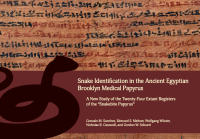Snake Identification in the Ancient Egyptian Brooklyn Medical Papyrus: A New Study of the Twenty-Four Extant Registers of the “Snakebite Papyrus”
Synopsis
This book is about snakebite and snake identification in ancient Egypt. The authors—in a remarkable collaboration between the fields of Egyptology, medicine, herpetology, biology, and ecology—offer a new examination of the Brooklyn Medical Papyrus, better-known as the Snakebite Papyrus, a pragmatic medical treatise concerned with snake identification, snakebite, and treatment. Dating to sometime in the seventh through fourth centuries BCE, the document is the first-known structured treatise on snakebites from antiquity.
The preserved paragraphs name 24 snakes (and one chameleon), providing a brief description of the snake, sometimes its habits, the appearance of its bite, and the effects on the victim. The papyrus was intended to enable the ancient physician to identify the snake from the description given by the patient in order to give appropriate prognosis and treatment. As there was little effective treatment for snake bites in ancient Egypt, sometimes the physician resorted to magical incantations to invoke divine assistance.
The Snakebite Papyrus was first translated into French by Serge Sauneron and published posthumously in 1989. Major advances in fields such as biogeography, climate and niche modeling, and linguistics in the past thirty years have brought new perspectives. The authors provide a review of Sauneron’s and more recent studies and bring their own investigations, results, and comparisons to further clarify this remarkable historical document.
Chapters
-
Front Matter


